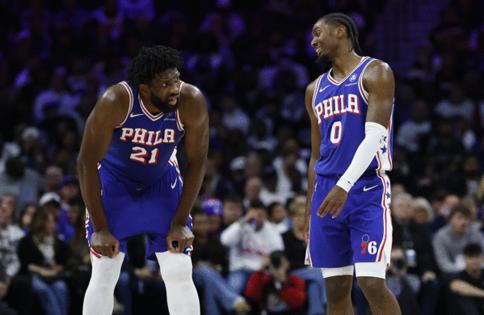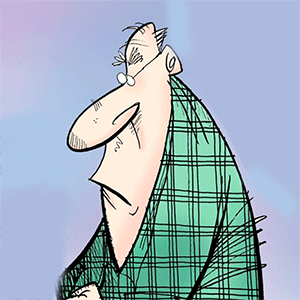Marcus Hayes: Latest injury to Joel Embiid feels like the end of hope for the Sixers as Paul George continues to hibernate
Published in Basketball
PHILADELPHIA — Yes, this is the 12th year of the Joel Embiid portion of The Process. He joined the Sixers one season into their ridiculous and catastrophic plan. He has been both their best player and their least dependable player.
He’s broken his eye sockets, torn up his knees, messed up a hand, and even had Bell’s palsy for a bit. But this one … this one seems different. It’s mundane, but still ominous, and rather final.
Before Tuesday’s game, the Sixers announced that Embiid would not play due to a new ailment: a sore right knee.
Seriously? He didn’t even play in the team’s last game, Sunday against Detroit. How did this happen? What, did he go bowling on Monday? Dammit, somebody find Andrew Bynum.
It was inevitable that Embiid would one day miss a game with an injury different from the left knee that has plagued him since his rookie season. It still plagues him today, forcing minutes restrictions and making every back-to-back a Sophie’s choice for team officials; he plays only one game or the other.
But when the announcement came, it came with a thud. A gut punch. It felt like an ending.
Not an ending of Embiid’s career.
No, it felt like the end of hope.
The hope that, between the wizardry of coach Nick Nurse and the brilliance of point guard Tyrese Maxey, Embiid could find a place in a system that might take advantage of the misfortune and foolhardiness of the Eastern Conference titans in New York, Boston, Indianapolis and Milwaukee.
The hope that, over the next four seasons, Embiid could be something more than a $50 million drain on the payroll.
Maybe it’s foolish that this one feels so dire. But it does.
Maybe it’s because, for the first time in his 12 years of employment, he has comported himself like a true professional. He reported to work in acceptable physical condition. He shows up to meetings on time. He’s not late for buses or planes.
He accepted a role that allows his teammates opportunities to contribute as complementary players, not coincidental players. He has maximized his efficiency in the limited games and the limited minutes he has played. His shot selection has been excellent, his court vision even better, and his attitude has never been more selfless or more team-oriented.
But now, from out of nowhere, with no traumatic event, with no collision or twist or bad landing, he’s got an achy right knee. It’s been the left knee that has caused him to miss 96 of a possible 184 games the previous two seasons.
The Sixers said Tuesday that there’s no structural damage. That makes it worse.
Why? Because despite his improved fitness, despite his minutes limits, he’s hurt. Again.
He’s hurt enough to miss one game, so you know he’s going to miss more.
If that isn’t fatalistic enough, it seems inevitable that these cracks in the dam will create a cascade of related injuries.
— Did this right knee pain present itself because of compensation by the right knee for the weaker left knee?
— Will this new injury cause more stress on the left knee, and impede its recovery?
— Will he be able to stay in shape with this new injury? It’s hard to work out with two bad knees.
— Will two achy knees on a substantial frame — even slimmed down, he looks as heavy as his listed weight of 280 — lead to even more ailments? Will the two bad knees affect his feet? His hips? His back?
Again, no sane person would expect Embiid’s return from two seasons of debilitating injury to proceed without incident. He’ll be 32 in March. He’s been injured, to some degree, in each of his 12 seasons, the first two of which he missed entirely with a fractured right foot.
Nevertheless, he had played six of the Sixers’ first 10 games.
He averaged 19.7 points, 5.5 rebounds, 1.5 blocks and 3.3 assists. Extrapolate those numbers per 36 minutes, and he exceeded his career averages in assists and blocks, and his scoring and rebounding numbers were just fine. On Saturday against Toronto, his most recent game, he’d scored a season-high 29 points, he’d played a season-high 25 minutes, 57 seconds, and he’d been a season-high plus-15.
Then, this.
Why was there hope?
Because, with and without Embiid, the Sixers won their first four games.
Because, with and without Embiid, the Sixers are 7-4 and hold second place in the Atlantic Division, having managed a two-point win Tuesday over Boston without him.
Because, with the continued ascendance of Maxey, the early returns on rookie VJ Edgecombe, and the expected production of second-year guard Jared McCain, who played his third game Tuesday, it looked like the Sixers might have some sort of formula to be competitive with the best teams in the East far into the spring.
That formula excludes any participation by Paul George, who apparently can practice at full tilt on his repaired knee but can’t play even one minute before Thanksgiving. The Sixers updated the status of his knee Tuesday, and while there doesn’t appear to have been any setbacks, at this point, don’t expect any real contribution from PG until Christmas.
He’s 35, he has missed 179 of 483 games in the last six-plus seasons, so, like Embiid, playing it safe with his body is his calling card. After all, he’s going to make $51.6 million this season whether he plays in 50 games or five.
Good work, if you can get it.
As it stands, the Sixers say Embiid is day to day. Of course, for most of his 12 NBA years, he’s been day to day. However, this is the first time he’s been day to day at the age of 31. In reality, Embiid probably will be day to day every day until the final day of his new three-year, $188 million contract.
A contract that kicks in next year.
©2025 The Philadelphia Inquirer, LLC. Visit at inquirer.com. Distributed by Tribune Content Agency, LLC.







Comments